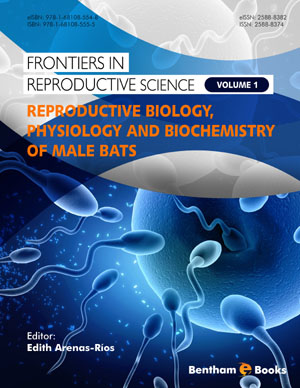Necropsy in Wildlife
Page: 1-20 (20)
Author: Andreia Garcês and Isabel Pires
DOI: 10.2174/9789811468339120010002
PDF Price: $15
Abstract
In this chapter, we express the importance of the post-mortem examination in wildlife conservation. The authors also describe the necessary equipment, the difficulties presented, and the samples that can be obtained from this procedure.
Sample Collection
Page: 21-27 (7)
Author: Andreia Garcês and Isabel Pires
DOI: 10.2174/9789811468339120010003
PDF Price: $15
Abstract
In this chapter, we describe the samples that can be collected from a cadaver in the field and during the post mortem exam.
Cadaveric Phenomenons
Page: 28-38 (11)
Author: Andreia Garcês and Isabel Pires
DOI: 10.2174/9789811468339120010004
PDF Price: $15
Abstract
In this chapter, we describe the main post-mortem alterations that can be observed in the process of decomposition of a cadaver.
Necropsy in Wild Birds
Page: 39-67 (29)
Author: Andreia Garcês and Isabel Pires
DOI: 10.2174/9789811468339120010005
PDF Price: $15
Abstract
In this chapter, we describe the method of necropsy in wild birds, offering some information regarding the different orders and anatomic characteristics of determining species.
Necropsy in Wild Mammals
Page: 68-101 (34)
Author: Andreia Garcês and Isabel Pires
DOI: 10.2174/9789811468339120010006
PDF Price: $15
Abstract
In this chapter, we describe the method of necropsy in wild mammals, offering some information regarding the different orders and anatomic characteristics of the determined species.
Necropsy in Reptiles
Page: 102-145 (44)
Author: Andreia Garcês and Isabel Pires
DOI: 10.2174/9789811468339120010007
PDF Price: $15
Abstract
In this chapter, we describe the method of necropsy in wild reptiles, offering some information regarding the different orders and anatomic characteristics of determined species.
Necropsy in Amphibians
Page: 146-156 (11)
Author: Andreia Garcês and Isabel Pires
DOI: 10.2174/9789811468339120010008
PDF Price: $15
Abstract
In this chapter, we describe the method of necropsy in wild amphibians, offering some information regarding the different orders and anatomic characteristics of determined species.
Necropsy in Invertebrates
Page: 157-161 (5)
Author: Andreia Garcês and Isabel Pires
DOI: 10.2174/9789811468339120010009
PDF Price: $15
Abstract
In this chapter, we describe the method of necropsy in invertebrates, offering some information regarding the different orders and anatomic characteristics of certain species.
Necropsy in Fish
Page: 162-171 (10)
Author: Andreia Garcês and Isabel Pires
DOI: 10.2174/9789811468339120010010
PDF Price: $15
Abstract
In this chapter, we describe the method of necropsy in fish, offering some information regarding the different orders and anatomic characteristics of the determined species.
Necropsy in Eggs
Page: 172-177 (6)
Author: Andreia Garcês and Isabel Pires
DOI: 10.2174/9789811468339120010011
PDF Price: $15
Abstract
In this chapter, we describe the method of necropsy in eggs of wild birds, in wildlife conservation. The authors also describe the necessary equipment, the difficulties presented, and the samples that can be obtained from this procedure.
Subject Index
Page: 178-186 (9)
Author: Andreia Garcês and Isabel Pires
DOI: 10.2174/9789811468339120010012
Introduction
In this handbook, the authors provide a practical, easily accessible guide of necropsy techniques for examining wildlife. Chapters introduce the reader to the value of necropsy in studying wildlife in general, sample collection methods, cadaveric phenomena and necropsy techniques for a variety of organisms ranging from invertebrates to mammals. The book addresses some of the peculiar characteristics of veterinary autopsy specific to different types of specimens. The goal of this book is to equip the reader with the information necessary to conduct a forensic examination in order to reach a conclusive diagnosis of an animal’s death, while also understanding it in an ecological context. Necropsy Techniques for Examining Wildlife Samples is intended as an essential handbook for students and professionals of biology, zoology and veterinary medicine as well as professionals, who work in natural parks, wildlife rehabilitation centers and biological or zoological parks as conservationists, researchers or animal handlers.








